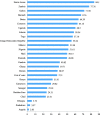Utilization of deworming medication and its associated factors among pregnant married women in 26 sub-Saharan African countries: a multi-country analysis
- PMID: 34193313
- PMCID: PMC8247116
- DOI: 10.1186/s41182-021-00343-x
Utilization of deworming medication and its associated factors among pregnant married women in 26 sub-Saharan African countries: a multi-country analysis
Abstract
Background: Deworming is one of the strategies to reduce the burden of anemia among pregnant women. Globally, pregnant women in sub-Saharan Africa are more affected by anemia. Therefore, this study examined both the coverage and demographic, socioeconomic, and women empowerment-related factors associated with the utilization of deworming medication among pregnant married women in sub-Saharan Africa.
Methods: We used data from the most recent Demographic and Health Surveys of 26 countries in sub-Saharan Africa conducted between 2010 and 2019. Using Stata version-14 software, analysis was done on 168,910 pregnant married women. Bivariate and multivariable logistic regression analyses were conducted to examine the factors associated with the utilization of deworming medication. The results were presented using adjusted odds ratios (aORs) at 95% confidence intervals (CIs).
Results: The pooled results showed that about 50.7% (95% CI 48.2-53.3%) of pregnant married women in the studied countries took deworming medications, and this varied from as high as 84.1% in Sierra Leone to as low as 2% in Angola. Regarding sub-regional coverage, the highest and lowest coverages were seen in East Africa (67.6%, 95% CI 66.0-69.1%) and West Africa (24.3%, 95% CI 22.4-26.4%) respectively. We found higher odds of utilization of deworming medication among older pregnant married women (aOR=1.93, 95% CI 1.32-2.84), women with educated husbands (aOR=1.40, 95% CI 1.11-1.77), wealthier women (aOR=3.12, 95% CI 1.95-4.99), women exposed to media (aOR=1.46, 95% CI 1.18-1.80), and those who had four or more antenatal care visits (aOR=1.51, 95% CI 1.24-1.83).
Conclusions: Enhancing women's education, disseminating information about maternal healthcare services through mass media, and ensuring that women from economically disadvantaged households benefit from national economic growth can be considered as deworming medication improvement strategies in sub-Saharan Africa. Moreover, providing more attention to adolescents or young pregnant women and increasing the number of antenatal care visits could be considered to increase deworming uptake among pregnant married women.
Keywords: DHS; Deworming; Factors; Global health; Pregnant women; Sub-Saharan Africa; Utilization.
Conflict of interest statement
The authors declare that they have no competing interests.
Figures



Similar articles
-
Women's decision-making capacity and its association with comprehensive knowledge of HIV/AIDS in 23 sub-Saharan African countries.Arch Public Health. 2022 Apr 6;80(1):111. doi: 10.1186/s13690-022-00849-8. Arch Public Health. 2022. PMID: 35387689 Free PMC article.
-
Utilization of Deworming Drugs and Its Individual and Community Level Predictors among Pregnant Married Women in Cameroon: A Multilevel Modeling.Biomed Res Int. 2021 May 12;2021:6645336. doi: 10.1155/2021/6645336. eCollection 2021. Biomed Res Int. 2021. PMID: 34095307 Free PMC article.
-
Pregnant women's decision-making capacity and adherence to iron supplementation in sub-Saharan Africa: a multi-country analysis of 25 countries.BMC Pregnancy Childbirth. 2021 Dec 13;21(1):822. doi: 10.1186/s12884-021-04258-7. BMC Pregnancy Childbirth. 2021. PMID: 34903198 Free PMC article.
-
Determinants of modern contraceptive utilization among married women in sub-Saharan Africa: multilevel analysis using recent demographic and health survey.BMC Womens Health. 2022 May 18;22(1):181. doi: 10.1186/s12905-022-01769-z. BMC Womens Health. 2022. PMID: 35585626 Free PMC article.
-
Explainable machine learning for modeling predictors of unintended pregnancy among married/in-union women in sub-Saharan Africa, a multi-country analysis of MICS 6 survey.Digit Health. 2024 Oct 24;10:20552076241292978. doi: 10.1177/20552076241292978. eCollection 2024 Jan-Dec. Digit Health. 2024. PMID: 39449856 Free PMC article. Review.
Cited by
-
A comprehensive assessment of deworming coverage among pregnant women in low- and middle-income countries, 2000-30.J Glob Health. 2024 Mar 1;14:04002. doi: 10.7189/jogh.14.04002. J Glob Health. 2024. PMID: 38419465 Free PMC article.
-
Women's decision-making capacity and its association with comprehensive knowledge of HIV/AIDS in 23 sub-Saharan African countries.Arch Public Health. 2022 Apr 6;80(1):111. doi: 10.1186/s13690-022-00849-8. Arch Public Health. 2022. PMID: 35387689 Free PMC article.
-
Community and individual level determinants and spatial distribution of deworming among preschool age children in Ethiopia: spatial and multi-level analysis.BMC Public Health. 2022 May 2;22(1):872. doi: 10.1186/s12889-022-13249-y. BMC Public Health. 2022. PMID: 35501790 Free PMC article.
-
Factors Associated with Deworming Medication Utilization among Pregnant Women in Benin: Evidence from the Demographic and Health Survey.Trop Med Infect Dis. 2023 Mar 12;8(3):166. doi: 10.3390/tropicalmed8030166. Trop Med Infect Dis. 2023. PMID: 36977167 Free PMC article.
-
Determinants of micronutrient supplementation during pregnancy among women in three sub-Saharan African countries: a multilevel logistic regression model.Front Glob Womens Health. 2024 Oct 25;5:1449259. doi: 10.3389/fgwh.2024.1449259. eCollection 2024. Front Glob Womens Health. 2024. PMID: 39524499 Free PMC article.
References
-
- World Health Organization. (2013b). Soil-transmitted helminth infections- fact sheet No. 366, Available at: http://www.sciepub.com/reference/328233. Accessed on 07 Apr 2021.
-
- Report of the WHO Advisory Group on deworming in girls and women of reproductive age. Rockefeller Foundation Bellagio Center, Bellagio, Italy. 28–30 June 2017 (WHO/ CDS/NTD/PCT/2018.01). Geneva: World Health Organization; 2018. Licence: CC BY-NC-SA 3.0 IGO.
-
- Bangert M, Bancalari P, Mupfasoni D, Mikhailov A, Gabrielli AF, Montresor A. Provision of deworming intervention to pregnant women by antenatal services in countries endemic for soil-transmitted helminthiasis. PLoS Negl Trop Dis. 2019;13(5):e0007406. doi: 10.1371/journal.pntd.0007406. - DOI - PMC - PubMed
LinkOut - more resources
Full Text Sources
